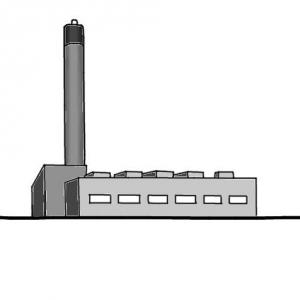Incineration or burning of non-recyclable solid waste helps to reduce the volume and the health risks related to the waste fraction to dispose. Incineration plants reduce volume (up to 90%) and weight (up to 75%) and break down hazardous substances such as pathogens and toxic chemicals. Flue gases must be treated in a complex treatment system after the combustion to avoid toxic emissions and the residual ashes have to be disposed of safely preventing leachate infiltration in order to protect human health and the environment. Large-scale incineration plants have a capacity up to 3000 tons per day and are high-tech and rather expensive. Incinerators for municipal solid waste is adapted where land for sanitary landfills is scarce, and financial and highly trained labourers are available. Moreover, heat, energy and precious metals may be recovered from the ashes and reuse. There are three main types of large-scale incinerators: mass-burn incinerators, fluidised-bed incinerators and modular incinerators
| In | Out |
|---|---|
Energy |
Integrated Waste Management (IWM) refers to the complementary use of a variety of practices to safely and effectively handle municipal solid waste. The strategy used to develop an integrated waste management system is to identify the level or levels at which the highest values of individual and collective materials can be recovered. The most favourable is reduction, which suggests using less to begin with and reusing more (e.g. separation of plastics, bottles, etc.; composting or anaerobic digestion and production of biogas from organic waste), thereby saving material production, resource cost, and energy. The least desirable is landfilling (AFRICAN DEVELOPMENT BANK 2002).
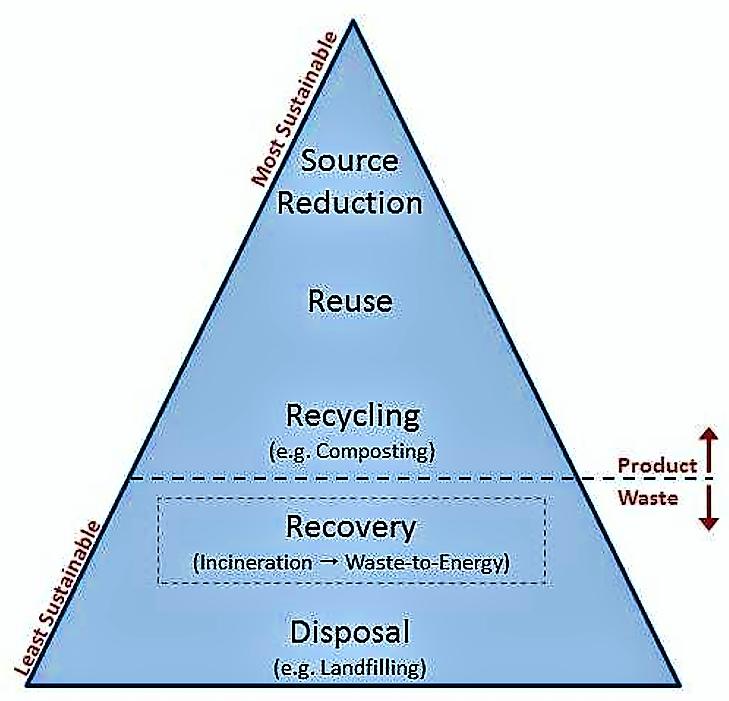
The primary benefit of municipal solid waste (MSW) incineration (see also small scale incineration) is a substantial reduction of the weight (up to 75%) and volume (up to 90%) of solid waste, which can be valuable if landfill space is scarce. The generation of revenues from energy production, known as waste-to-energy incineration, can also partially offset the cost of incineration, although there are typically less expensive forms of energy production available. Moreover, incineration breaks down some hazardous, non-metallic organic wastes and destroys bacteria and viruses, which is the main benefit of incineration of medical wastes (read more about incineration of medical waste in UNEP (1996, Chapter 1.7.2). Moreover, some precious metals may be recovered from the residual ashes. However, the design of large-scale incinerators is high-tech but crucial for an environmentally sound and healthy operation: in particular, the correct treatment of the toxic flue gases and the safe disposal of residual ashes (preventing soil and groundwater pollution) have to be considered.
In considering the MSW incineration option, decision makers must weigh the benefits of incineration against the significant capital and operating costs, potential environmental impacts, and technical difficulties of operating an incinerator (adapted from UNEP 1996). Open burning of MSW must be avoided. Read more about it here.
MSW incineration can constitute a sound practice only in situations where most or all of the following conditions hold (adapted from UNEP 1996):
- Suitable landfill space is scarce, making incineration a cost-effective alternative.
- The necessary environmental controls are properly installed and maintained.
- The facility is properly sized and sited to fit well with other components of the MSW management (MSWM) system.
- The material to be burned is combustible and has sufficient energy content.
- There are nearby energy markets.
(Adapted from UNEP 1996)
Mass-burn Incinerator
Mass-burn systems are the predominant form of MSW incineration. Mass-burn systems generally consist of either two or three incineration units ranging in capacity from 50 to 1,000 tons per day; thus, facility capacity ranges from about 100 to 3,000 tons per day. These facilities can accept refuse that has undergone little pre-processing other than the removal of oversized items, such as refrigerators and sofas. Although this versatility makes mass-burn facilities convenient and flexible, local programs to separate household hazardous wastes (e.g., cleaners and pesticides) and recover certain materials (e.g., iron scrap) are necessary to help ensure environmentally responsible incineration and resource conservation.
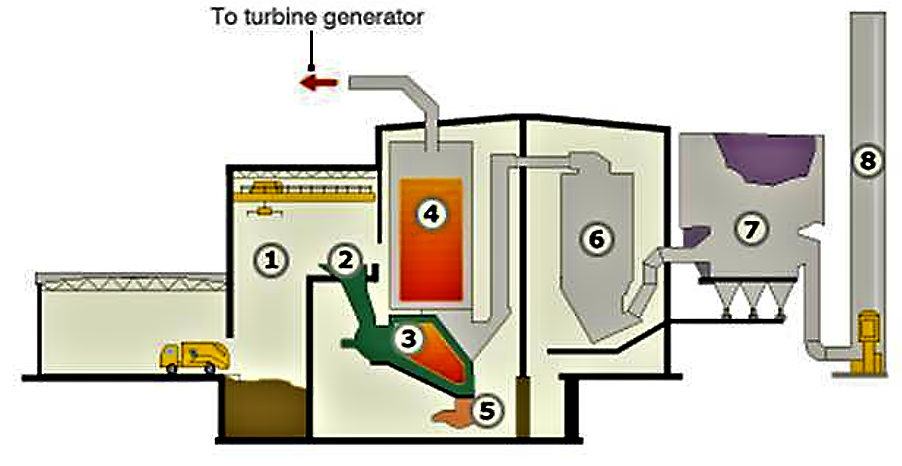
Fluidised-bed Incinerator
In a fluidised-bed incinerator, the stoker grate is replaced by a bed of limestone or sand that can withstand high temperatures, fed by an air distribution system. The heating of the bed and the increasing of the air velocities cause the bed to bubble, which gives rise to the term ‘fluidised’. There are two types of fluidised-bed technologies, a bubbling bed and a circulating bed. The differences are reflected in the relationship between air flow and bed material, and have implications for the type of wastes that can be burned, as well as the heat transfer to the energy recovery system. They are widely used in Japan and have a capacity between 50 and 150 tons per day.
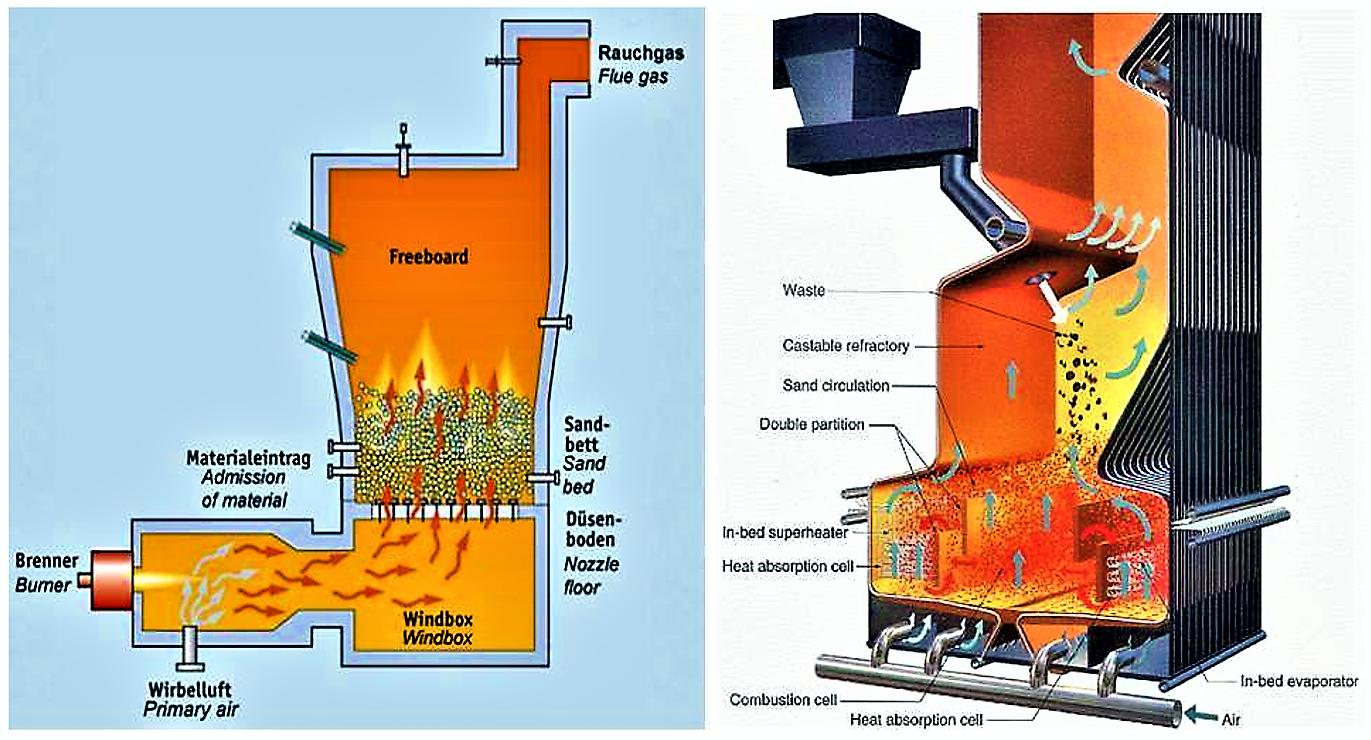
Modular Incinerator
Modular incinerator units are usually prefabricated units with small to medium capacities of between 5 and 120 tons of solid waste per day. Typical facilities have between one and four units for a total plant capacity of about 15 to 400 tons per day. The majority of modular units produce steam as the sole energy product. Due to their small capacity, modular incinerators are generally used in smaller communities or for commercial and industrial operations. Their prefabricated design gives modular facilities the advantage of shorter construction times. On average, capital costs per ton of capacity are lower for modular units than for other MSW incineration options.
Modular incinerators employ a somewhat different process than mass-burn incinerators, typically involving two combustion chambers. Gases generated in the primary chamber flow to an afterburner, which ensures more complete combustion and often serves as the primary means of pollution control. In addition, smaller-scale plants (i.e., less than 50 tons per day) sometimes operate using a batch process, rather than continuously, operating only 8 to 16 hours per day. The modular incineration option has become less common, however, in part due to concerns over the consistency and adequacy of air pollution controls.
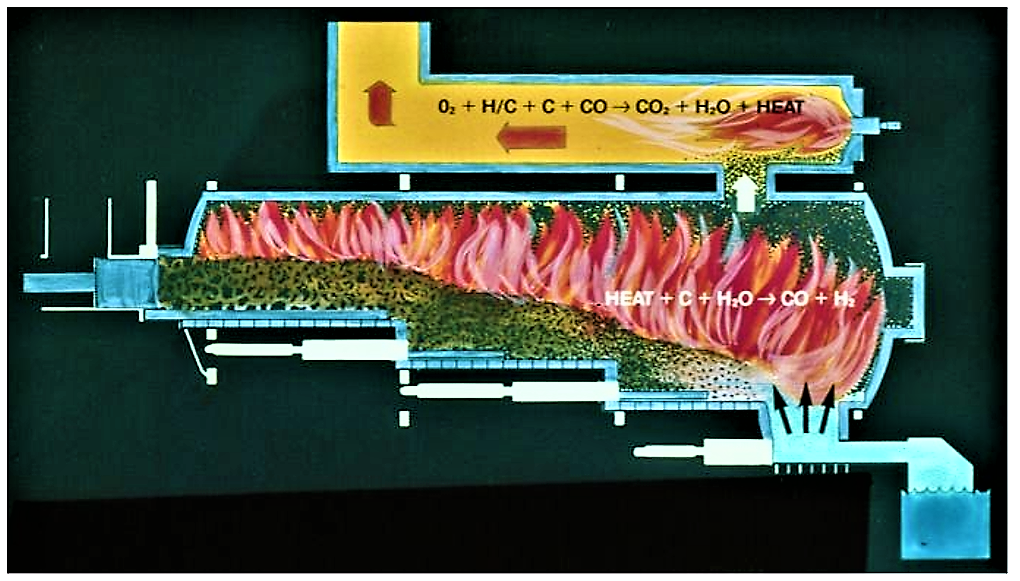
Sludge Incineration
Incineration of dewatered sludge (check out some techniques to dewater sewerage sludge: drying beds; settling - thickening ponds; mechanical dewatering) from wastewater treatment plants reduces the volume of the dry sludge and produces a sterile non-harmful residue that is free from toxic organic chemicals and pathogens. It provides a safe alternative solution when faced with land scarcity for waste disposal and if anaerobic digestion or composting is not an option. Moreover, it also helps to recover some of the energy used in the combustion process especially in large treatment plants whereby there is a huge quantity of sludge generation (WASTEWATER SYSTEM n.y). The disposal of sewage sludge along with the incineration of household rubbish can be integrated both in newly planned plants as well as retrofitted in older plants (PUTZMEISTER 2000).
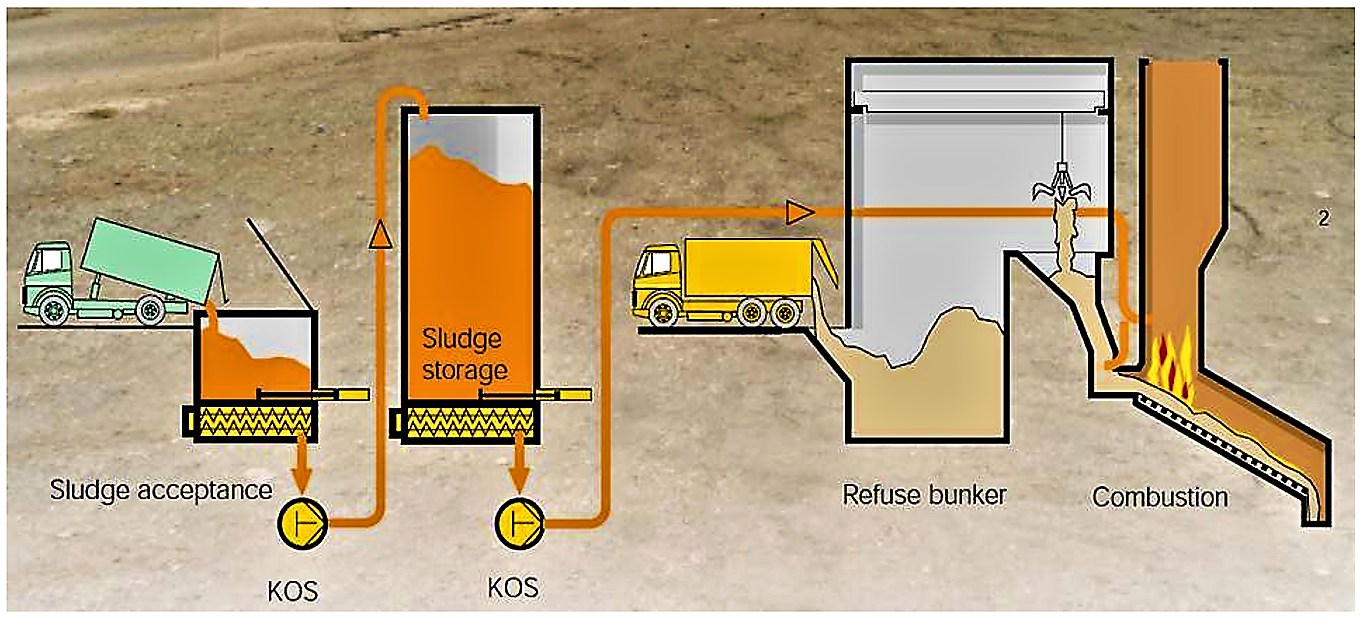
Furthermore, with the implementation of new technologies (e.g. Ash Dec), multi-nutrient fertiliser can be produced out of sewage sludge. The thermo-chemical process in Ash Dec removes toxic heavy metals and makes it harmless for the environment. This allows closing the nutrient cycle.
MSW incineration is typically only cost-effective in regions where land suitable for landfilling is scarce. Such landfill scarcity can arise due to geographical constraints, as with a highly urbanised region or island, or environmental conditions, as in regions where the water table is high. Jurisdictional and political boundaries can also constrain the size and number of sites available for landfilling, thereby increasing the attractiveness of incineration (adapted from UNEP 1996).
In addition to heat, the products of incineration include the normal primary products of combustion—carbon dioxide and water—as well as oxides of sulphur and nitrogen and other gaseous pollutants; nongaseous products include fly ash and unburned solid residue. Emissions of fly ash and other particles are often controlled by wet scrubbers, electrostatic precipitators, and bag filters (ABUBAKAR 2006). Read more about incinerators and their impacts on human health and the environment in GAIA (2008).
Incineration systems must have complex air pollution control (APC) systems in order to meet the required limits for protecting the quality of the ambient air and human health. Therefore, the institutional framework and policies are crucial in order to enforce that environmental and health standards are met. The complexity is a result of the fact that modern APC systems include provisions for controlling a number of pollutants to very low concentrations (e.g., parts per million or per billion). The provisions include control and manipulation of the combustion process itself within the combustion chamber and the use of post-combustion techniques, including the use of chemical reagents and of special mechanical and electrical systems to process the combustion gases (UNEP 2005).
Highly specialised personnel must service APC equipment regularly. Monitoring equipment is costly and requires aggressive maintenance and servicing by trained technicians. In summary, when incineration is done in a manner that has low adverse health and environmental impacts, it is expensive. When it is done poorly (with low financial costs) it can be expensive in terms of human health and environmental impacts.

| Working Principle | It is basically the process of combusting solid waste (or dried sludge from wastewater treatment plants) under controlled, approximately stoichiometric conditions to reduce its weight and volume, and often to produce energy (electricity, heat). |
| Capacity/Adequacy | It is a common practice in many developing and industrialised countries. |
| Performance | Performance is high if the incineration plant is on a high technological level. |
| Costs | Very high |
| Self-help Compatibility | Low |
| O&M | Needs expert knowledge |
| Reliability | Mostly reliable, but there is a risk of malfunction if not properly maintained and operated. |
| Main strength | No landfills required, substantial reduction of the weight (up to 75%) and volume (up to 90%) of solid waste. |
| Main weakness | Costs, gas emissions, residual ashes. |
Incineration is suitable only after the maximum of reusable and recyclable material has been separated (plastics, organics, etc.). It is only cost-effective in regions where land suitable for landfilling is scarce due to geographical constraints (i.e. in urbanised regions or islands) or in regions where the water table is high. Jurisdictional and political boundaries can also constrain the size and number of sites available for landfilling, thereby increasing the attractiveness of incineration. At the present time, there are factors that make incineration difficult or inadvisable in many developing countries. Notable among them are the high capital and operating costs involved relative to national income levels, and the comparatively low cost of sanitary landfilling (UNEP 1996).
Municipal Solid Waste Management: Options for Developing Countries
Waste is generally defined as any material that is no longer needed or no longer useful to the owner. Wastes can be solid, liquid or gaseous, however, our focus is on solid wastes. Japan and the European Union have embarked on a different approach to reduce the materials that require landfilling. They use various conversion technologies such as composting and thermal treatment. What about the rest of the world? Open dumps – controlled or uncontrolled continue to receive solid waste every day. They constitute the most serious threat to global environmental quality. China, south Asia, Africa and South America are regions where open dumps continue to prevail. In Nigeria today, the open dumps are neither even organised nor controlled. People can just dump anything anywhere.
ABUBAKAR, M.B. (2006): Municipal Solid Waste Management: Options for Developing Countries. Kaduna: EEMS LimitedStudy on Solid Waste Management Options for Africa
Waste generation, both domestic and industrial, continues to increase worldwide in tandem with growth in consumption. In developed countries, per capita waste generation increased nearly three-fold over the last two decades, reaching a level five to six times higher than that in developing countries. With increases in populations and living standards, waste generation in developing countries is also increasing rapidly, and may double in volume in the current decade. If current trends continue, the world may see a five-fold increase in waste generation by the year 2025. A high proportion of the waste could be recycled by the urban poor generating income for themselves and protecting the environment. There is a need to develop an integrated approach where the public, private and community sectors work together to develop local solutions promoting sustainable solid waste management.
AFRICAN DEVELOPMENT BANK (2002): Study on Solid Waste Management Options for Africa. Abidjan: African Development Bank (ADB). Accessed: 13.03.2012] PDFBurn Baby Burn
CONSUMAT Controlled-Air Incinerator
Flue Gas Cleaning in Hannover
Waste Disposal - Eisenmann Fluidized Bed Incineration
Incinerators Trash Community Health
The incinerator industry often promotes incinerators as having “zero emissions” or as being “safe for community health”. The truth, however, is that all incinerators contaminate people and the environment with toxic and cancer-causing emissions.
GAIA (2008): Incinerators Trash Community Health. Quezon City: Global Alliance for Incinerator Alternatives (GAIA) URL [Accessed: 10.06.2019]Internal Circulation Fluidized Bed Incinerator
Sewage Sludge Incineration with Household Rubbish
The disposal of de-watered sewage sludge is an important point nowadays in refuse disposal. A very environmentally-friendly and favourably-priced possible disposal is burning it along with dewatered sewage sludge in household rubbish incinerators. Existing projects show that, when both are burnt together, this does not lead to higher emissions, the investment costs are low and the sludge can be disposed of in an environmentally- compatible manner and economically. Putzmeister offers turn-key complete solutions for storage, transport and the feeding of refuse into the combustion chambers.
PUTZMEISTER (2000): Sewage Sludge Incineration with Household Rubbish. Aichtal: Putzmeister Holding GmbH URL [Accessed: 14.03.2012]International Source Book on Environmentally Sound Technologies (ESTs) for Municipal Solid Waste Management (MSWM)
The publication provides a list of information sources as well as overviews of practices in the world regions relating to environmentally sound management of municipal solid waste (waste reduction, collection and transfer, composting, incineration, landfills, special wastes, waste characterization, management and planning, training, public education and financing).
UNEP (1996): International Source Book on Environmentally Sound Technologies (ESTs) for Municipal Solid Waste Management (MSWM). Nairobi: United Nations Environment Programme (UNEP) URL [Accessed: 13.03.2012]Solid Waste Management
The collection, transport, treatment, and disposal of solid wastes, particularly wastes generated in medium and large urban centres, have become a relatively difficult problem to solve for those responsible for their management. The problem is even more acute in economically developing countries, where financial, human, and other critical resources generally are scarce. This publication has been prepared primarily for two audiences: 1) decision-makers and policy makers, and 2) professionals involved in the management of solid wastes. The information in the publication would also be useful to students in environmental engineering. The material is presented such that most chapters need not be read in any particular sequence. However, if a formal class is based on the book, the chapters should be covered in sequential order.
UNEP (2005): Solid Waste Management. Nairobi: United Nations Environment Programme (UNEP) URL [Accessed: 10.06.2019]Wastewater Sludge Incineration Technologies
Municipal Solid Waste Management: Options for Developing Countries
Waste is generally defined as any material that is no longer needed or no longer useful to the owner. Wastes can be solid, liquid or gaseous, however, our focus is on solid wastes. Japan and the European Union have embarked on a different approach to reduce the materials that require landfilling. They use various conversion technologies such as composting and thermal treatment. What about the rest of the world? Open dumps – controlled or uncontrolled continue to receive solid waste every day. They constitute the most serious threat to global environmental quality. China, south Asia, Africa and South America are regions where open dumps continue to prevail. In Nigeria today, the open dumps are neither even organised nor controlled. People can just dump anything anywhere.
ABUBAKAR, M.B. (2006): Municipal Solid Waste Management: Options for Developing Countries. Kaduna: EEMS LimitedStudy on Solid Waste Management Options for Africa
Waste generation, both domestic and industrial, continues to increase worldwide in tandem with growth in consumption. In developed countries, per capita waste generation increased nearly three-fold over the last two decades, reaching a level five to six times higher than that in developing countries. With increases in populations and living standards, waste generation in developing countries is also increasing rapidly, and may double in volume in the current decade. If current trends continue, the world may see a five-fold increase in waste generation by the year 2025. A high proportion of the waste could be recycled by the urban poor generating income for themselves and protecting the environment. There is a need to develop an integrated approach where the public, private and community sectors work together to develop local solutions promoting sustainable solid waste management.
AFRICAN DEVELOPMENT BANK (2002): Study on Solid Waste Management Options for Africa. Abidjan: African Development Bank (ADB). Accessed: 13.03.2012] PDFIncinerators Trash Community Health
The incinerator industry often promotes incinerators as having “zero emissions” or as being “safe for community health”. The truth, however, is that all incinerators contaminate people and the environment with toxic and cancer-causing emissions.
GAIA (2008): Incinerators Trash Community Health. Quezon City: Global Alliance for Incinerator Alternatives (GAIA) URL [Accessed: 10.06.2019]Guidelines for the Utilisation and Disposal of Wastewater Sludge
Traditional practices related to wastewater sludge management include dedicated land disposal, waste piling, landfill disposal and, to a lesser degree, use in agricultural practices. However, due to varying reasons, on-site land disposal and waste piling have become the standard management options for many wastewater treatment plants in South Africa today. With sludge production increasing on a daily basis, it has however become apparent that current practices are unsustainable with sludge management becoming a problem for many municipalities in South Africa. Innovative solutions need to be sought to create opportunities that provide a wide spectrum of options to the management of wastewater sludge. This guideline aims to provide options and opportunities for this innovation and to encourage the beneficial use of wastewater sludge. Where wastewater sludge cannot be used as a resource, the guidelines also provide for its disposal in a responsible manner.
HERSELMAN, J. E. BURGER, L. W. MOODLEY, P. (2008): Guidelines for the Utilisation and Disposal of Wastewater Sludge. Volume 5: Requirements for thermal sludge management practices and for commercial products containing sludge. Pretoria: Water Research Commission (WRC) URL [Accessed: 19.03.2012]Sewage Sludge Incineration
A factsheet about sewage sludge incineration and its possibilities.
NEIWPCC (2001): Sewage Sludge Incineration. Lowell: New England Interstate Water Pollution Control Commission (NEIWPCC) URL [Accessed: 14.03.2012]Sewage Sludge Incineration with Household Rubbish
The disposal of de-watered sewage sludge is an important point nowadays in refuse disposal. A very environmentally-friendly and favourably-priced possible disposal is burning it along with dewatered sewage sludge in household rubbish incinerators. Existing projects show that, when both are burnt together, this does not lead to higher emissions, the investment costs are low and the sludge can be disposed of in an environmentally- compatible manner and economically. Putzmeister offers turn-key complete solutions for storage, transport and the feeding of refuse into the combustion chambers.
PUTZMEISTER (2000): Sewage Sludge Incineration with Household Rubbish. Aichtal: Putzmeister Holding GmbH URL [Accessed: 14.03.2012]International Source Book on Environmentally Sound Technologies for Municipal Solid Waste Management
This Source Book is directed towards municipal solid waste management decision makers of developing countries and countries in transition, non-governmental organisations and community-based organizations involved in waste management. The book serves as a general reference guide to researchers, scientists, science and technology institutions and private industries on a global state-of-the-art on environmentally sound technologies for municipal solid waste management. It provides a list of information sources and overviews of practices in the world regions relating to environmentally sound management of municipal solid waste (waste reduction, collection and transfer, composting, incineration, landfills, special wastes, waste characterization, management and planning, training, public education and financing). Parts of the book can be viewed within this website.
UNEP ; IETC (1996): International Source Book on Environmentally Sound Technologies for Municipal Solid Waste Management. United Nations Environment Programme (UNEP) and International Environmental Technology Centre Japan (IETC) URL [Accessed: 28.04.2010]Solid Waste Management
The collection, transport, treatment, and disposal of solid wastes, particularly wastes generated in medium and large urban centres, have become a relatively difficult problem to solve for those responsible for their management. The problem is even more acute in economically developing countries, where financial, human, and other critical resources generally are scarce. This publication has been prepared primarily for two audiences: 1) decision-makers and policy makers, and 2) professionals involved in the management of solid wastes. The information in the publication would also be useful to students in environmental engineering. The material is presented such that most chapters need not be read in any particular sequence. However, if a formal class is based on the book, the chapters should be covered in sequential order.
UNEP (2005): Solid Waste Management. Nairobi: United Nations Environment Programme (UNEP) URL [Accessed: 10.06.2019]Best Available Techniques (BAT) and Best Environmental Practices (BEP) for the Incineration of Municipal Waste
The environmentally sound design and operation of municipal waste incinerators requires the use of best environmental practices and best available techniques to prevent or minimise the formation and release of the unintentional POPs. The purpose of this guidance is to identify such practices and techniques, summarise their effectiveness, and estimate their relative cost, for consideration by the Parties in the development of national action plans under the Stockholm Convention on Persistent Organic Pollutants.
UNEP (2003): Best Available Techniques (BAT) and Best Environmental Practices (BEP) for the Incineration of Municipal Waste. Nairobi: United Nations Environment Programme (UNEP). [Accessed: 13.03.2012] PDFDeveloping Integrated Solid Waste Management Plan – Training Manual
This document is the fourth and last of the four sets of guidelines on ISWM. It focuses on how to develop an ISWM Plan by utilizing the information collected and generated with the help of the previous three sets of the guidelines. This document could also be used as a standalone document to build the capacity of experts and policy makers on planning for ISWM.
UNEP (2009): Developing Integrated Solid Waste Management Plan – Training Manual . (= ISWM Plan , 4 ). Osaka/Shiga, Japan: UNEP URL [Accessed: 29.10.2012]Waste and Climate Change
This report is intended as a further step in a global dialogue to engage the international waste community, identify the key issues, and create a strategy that will deliver significant climate benefit in the waste sector.
UNEP (2010): Waste and Climate Change. Osaka/Shiga: United Nations Environment Programme (UNEP) URL [Accessed: 19.03.2012]Municipal Solid Waste Incineration
Solid waste management is in crisis in many of the world’s largest urban areas as populations attracted to cities continue to grow. This has led to ever increasing quantities of domestic solid waste while space for disposal decreases. This report should be used with caution since both technical and financial feasibility are very site-specific. Readers with general interest and technical specialists will find this report useful in making their assessments. A comprehensive solid waste management program may include several options phased in over a long period of time during which refuse quantities, constituents and the overall economic picture may change significantly. This uncertainty and associated risks must be incorporated into the planning process.
WORLDBANK (1999): Municipal Solid Waste Incineration. Washington D.C.: The World Bank URL [Accessed: 10.06.2019]Sludge Treatment and Disposal
Sludge Treatment and Disposal is the sixth volume in the series Biological Wastewater Treatment. The book covers in a clear and informative way the sludge characteristics, production, treatment (thickening, dewatering, stabilisation, pathogens removal) and disposal (land application for agricultural purposes, sanitary landfills, landfarming and other methods). Environmental and public health issues are also fully described.
ANDREOLI, C.V. ; SPERLING, M. von ; FERNANDES, F. (2007): Sludge Treatment and Disposal. (= Biological Wastewater Treatment Series , 6 ). London: International Water Association (IWA) Publishing URL [Accessed: 27.05.2019]Solid Waste Management in Nepal. Facsheet
This 12-page factsheet reflects the existing management systems practiced in various areas of Nepal in managing solid waste and contains initiatives of Municipalities; national and local NGOs/CBOs; public and private entities. The paper helps to transfer the lessons and existing practices regarding solid waste management and encourages urban, peri-urban and emerging towns for similar initiatives in urban sanitation.
WATERAID NEPAL ; ENPHO (2008): Solid Waste Management in Nepal. Facsheet. Kathmandu: WaterAid Nepal Environment and Public Health Organization (ENPHO) URL [Accessed: 01.06.2019]Pollution and Health Impacts of Waste Incinerators
Read more about environmental problems caused by incineration plants in the United Kingdom.
GREENPEACE (n.y): Pollution and Health Impacts of Waste Incinerators. London: Greenpeace U.K. URL [Accessed: 10.06.2019]A Study on Waste Incineration Activities in Nairobi that Release Dioxin and Furan into the Environment
This report outlines the findings of a study carried out in and around the city of Nairobi, Kenya by ENVILEAD. The study was carried out between the months of January and March 2005, about the patterns of practice that are likely to release persistent organic pollutants (POPs) into the environment as part of the International POPs Elimination Project (IPEP’s) initiatives. The focus of the study was the practice of medical and municipal waste burning, which research has shown to be a potential source of unintentional POPs (UPOPs). The study’s objective was to investigate the anatomy of this practice, identify the key issues involved and make recommendations for the way forward.
ENVILEAD (2005): A Study on Waste Incineration Activities in Nairobi that Release Dioxin and Furan into the Environment. Nairobi: Environmental Liaison, Education and Action for Development (ENVILEAD) URL [Accessed: 10.06.2019]Selected POPs Waste “Hot Spots” around the World
Some of the POPs are pesticides; others are industrial chemicals; and some occur as unintentional by-products of chemical and combustion processes. Learn more about the “hot spots” in this paper.
IPEN (2009): Selected POPs Waste “Hot Spots” around the World. Prague: Arnika Association URL [Accessed: 15.03.2012]Burn baby burn
Article: “Britain's sitting on a waste time bomb - we must recycle more and bury less... and quickly. But there is a third option, which those models of eco-awareness, the Danes, don't even blink at: burning it. Simon Cox finds out whether the British can ever be won over.”
Wastewater Sludge Incineration Technologies
A short article about waste incineration technologies.


